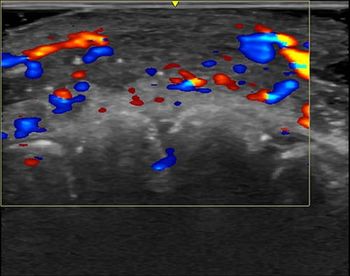Findings from a new multinational study looking at an AI modality for digital breast tomosynthesis (DBT) show significantly higher standalone specificity and comparable AUC and sensitivity to 15 reviewing radiologists, including seven breast imaging specialists.
For the retrospective research, recently published in Radiology: Artificial Intelligence, researchers performed two studies to assess a deep learning AI modality for DBT. They examined standalone performance of the AI platform in 2,202 cases, including 1,102 cases involving breast cancer. The study authors also compared adjunctive use of the AI modality versus DBT interpretation of eight general radiologists and seven breast radiologists from the United States and South Korea. The reader study cohort was comprised of 258 women (mean age of 56), according to the study.
The researchers found that standalone AI and adjunctive AI had a 92 percent area under the curve (AUC) in comparison to 90 percent without AI. Standalone AI had comparable sensitivity (84.62 percent) to unassisted radiologist reading (85.44 percent) but was slightly more than 3 percent lower than the use of adjunctive AI (87.69 percent).
In contrast, the study authors noted that standalone AI had a 10 percent higher specificity rate (89.64 percent) than adjunctive AI (79.62 percent) and a greater than 8 percent lower recall rate (29.07 percent vs. 37.34 percent). The researchers also pointed out a nearly six-second reduction in mean reading time per case for adjunctive AI (48.52 seconds in comparison to 54.41 seconds for unassisted reading).
“The standalone AI performance measured by AUC was higher than that of radiologists alone. When the AI model was used in conjunction with radiologists, their diagnostic performance improved significantly and reading times were significantly reduced,” wrote study co-author Eun-Kyung Kim, M.D., Ph.D., who is affiliated with the Department of Radiology at Yongin Severance Hospital and the College of Medicine at Yonsei University in Yongin, Korea, and colleagues.
The researchers found that standalone AI had a 95 percent AUC for fatty breasts in comparison to 93 percent for adjunctive AI and 91 percent for unassisted reading. For dense breasts, standalone use of AI demonstrated an 89 percent AUC in contrast to 91 percent for adjunctive AI and 88 percent for radiologist interpretation. The study authors also pointed out that adjunctive AI led to reading time reductions of 4.52 seconds and 7.32 seconds per DBT image for fatty and dense breasts respectively.
Three Key Takeaways
- Improved specificity with standalone AI. The study demonstrates that standalone AI for digital breast tomosynthesis (DBT) exhibits significantly higher specificity compared to radiologist interpretation, indicating its potential in reducing false positives and unnecessary recalls.
- Enhanced diagnostic performance with adjunctive AI. When used adjunctively, the AI modality improved diagnostic performance, achieving slightly higher sensitivity and specificity overall than unassisted radiologist reading, suggesting its utility as a complementary tool in clinical practice.
- Efficiency gains with AI adoption. Incorporating AI into DBT interpretation may not only enhance diagnostic accuracy but could lead to substantial reductions in reading time per case, indicating potential workflow improvements and efficiency gains in breast imaging departments.
“Significantly improved AUCs and reduced reading times were observed in both fatty and dense breasts, with increased sensitivity in fatty breasts and increased specificity in dense breasts,” noted Kim and colleagues.
While the researchers found comparable AUCs and reading times among standalone AI, adjunctive AI, and unassisted reading for calcification-only lesions, they noted that standalone AI and adjunctive AI had higher AUCs (89 percent and 88 percent) versus unassisted reading (83 percent) for soft tissue lesions. The study authors also noted a nearly 10 second reduction in reading time for adjunctive AI (42.25 seconds) over unassisted reading (51.75 seconds) for soft tissue lesions.
“Improvements in sensitivity and specificity were greater for cases with soft tissue lesions than for (calcification-only) lesions, suggesting that AI can be useful for detecting and diagnosing soft tissue lesion on DBT,” added Kim and colleagues.
(Editor’s note: For related content, see “GE HealthCare Launches AI Mammography Platform with Key Applications from iCAD,” “FDA Clears Lunit’s AI-Powered Digital Breast Tomosynthesis Platform” and “Digital Mammography Meta-Analysis Suggests AI Performs as Well as Radiologists.”)
In regard to study limitations, the authors noted the cancer-enriched dataset and comparing the single exam reading capabilities of the AI system to radiologists who can compare current and prior imaging studies.





























